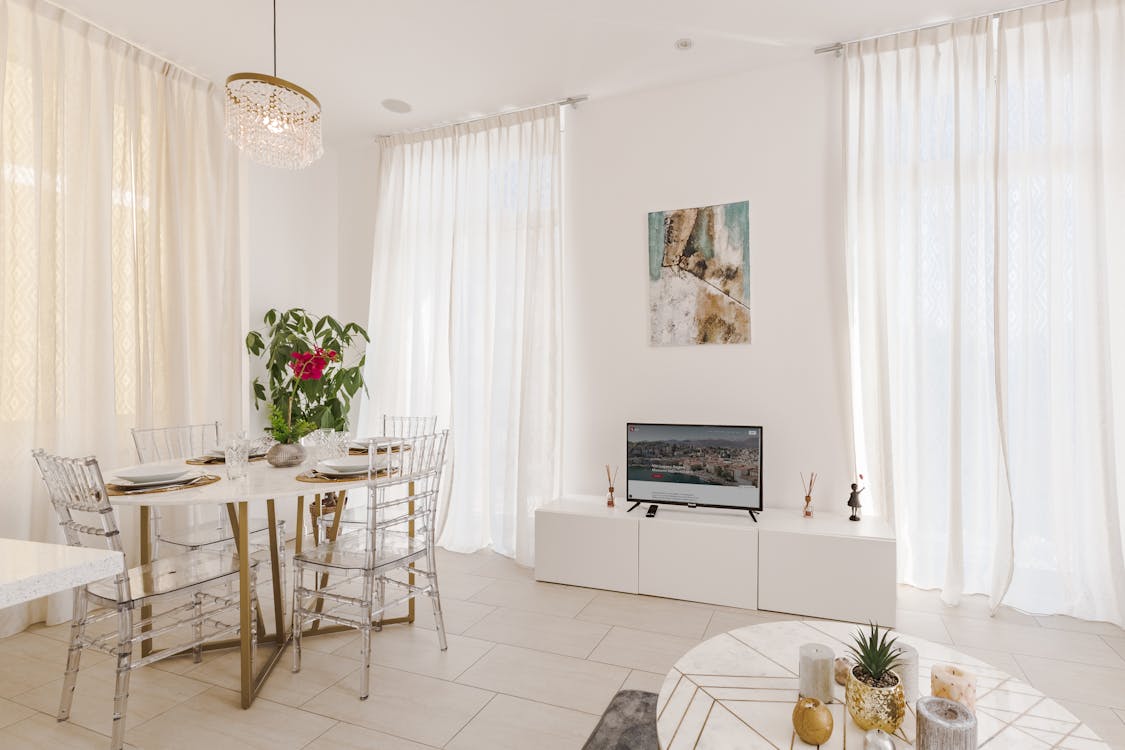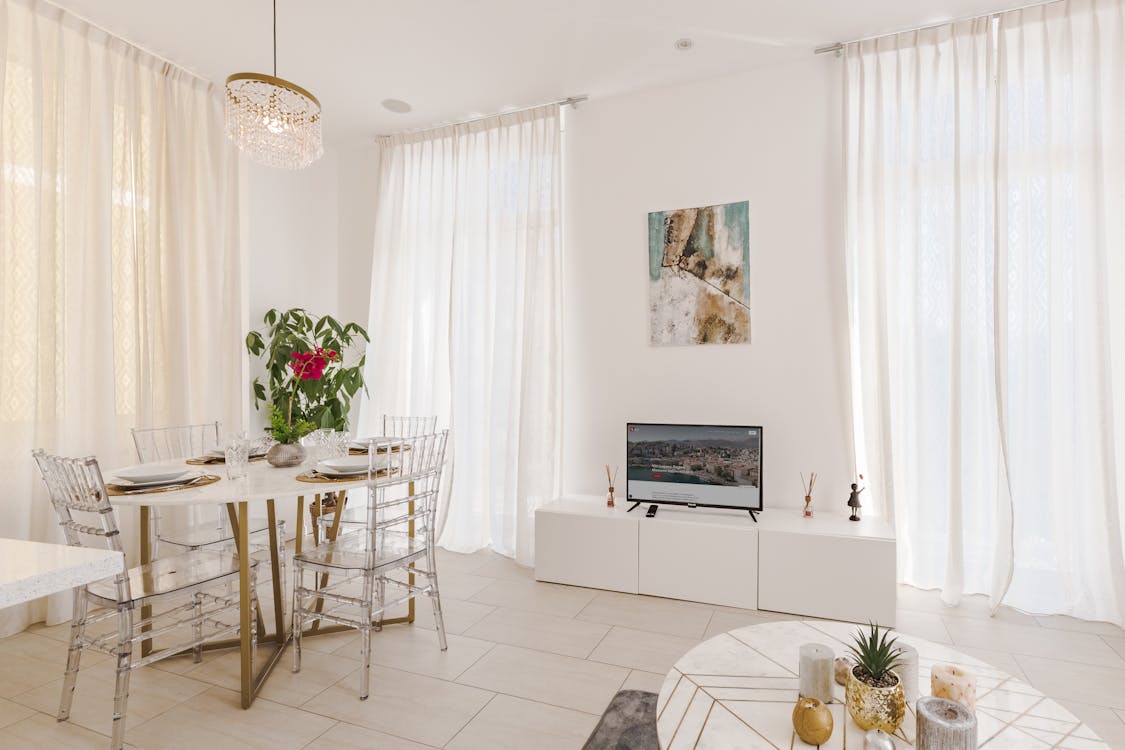
How to Choose the Perfect Dining Room Curtains for Your Home

When I think about transforming a dining room, curtains often come to mind as a simple yet powerful tool. They do more than cover windows—they set the tone for the entire space. For instance, red curtains can create a warm, inviting atmosphere that enhances the dining experience. Curtains also highlight beautiful furniture, making the room feel more cohesive. Choosing colors that complement the existing decor ensures a polished look. With the growing demand for eco-friendly materials and innovative designs, dining room curtains have become essential for blending style with functionality.
Key Takeaways
Think about your dining room's style before picking curtains. Match the curtain fabric to the room's design for a neat look.
Look at window size and sunlight when choosing curtains. Use light fabrics for sunny rooms and thick ones for strong sunlight.
Pick colors that match your dining room's mood. Warm colors feel cozy, and cool colors feel calm.
Focus on how you will use the curtains. Decide if they block light, give privacy, or just look nice.
Save money with cheap curtains or DIY ideas. Mixing styles can make your room special without spending too much.
Assess Your Dining Room’s Style and Needs
Identify the room’s design theme (formal, casual, or eclectic)
When choosing dining room curtains, I always start by identifying the room’s design theme. Is the space formal, casual, or eclectic? A formal dining room often benefits from luxurious fabrics like velvet or silk, which add elegance. For a casual setting, I prefer lightweight materials like linen or cotton that feel relaxed and inviting. An eclectic style allows for more creativity, blending bold patterns or textures to make a statement.
Tip: Mixing and matching curtain colors with existing elements, such as rugs or artwork, can enhance the overall design. Amy Peltier, a design expert, recommends this approach for creating a cohesive look.
Current trends also influence my choices. Sleek, minimalist designs with neutral tones work well for understated elegance. On the other hand, maximalist styles with rich textures and bold patterns are perfect for those who want to make a dramatic impact.
Evaluate window size, placement, and natural light
Window size and placement play a huge role in selecting the right curtains. I always measure the windows first to ensure a perfect fit. If standard sizes don’t work, custom drapery panels are a great option. Curtains that touch the floor create a polished and sophisticated look.
Natural light is another factor I consider. For example:
Window Type |
Light Characteristics |
|---|---|
North-facing |
Provides consistent, soft light without direct sunlight. |
South-facing |
Captures the most sunlight throughout the day. |
East-facing |
Offers bright, morning sunlight. |
West-facing |
Provides strong, afternoon light, which can be intense. |
For rooms with abundant sunlight, sheer curtains diffuse light beautifully while reducing glare. In contrast, blackout curtains are ideal for controlling light in spaces with intense afternoon sun.
Consider existing decor, furniture, and color palette
Curtains should complement the room’s decor and furniture. I like to pull colors from existing elements, such as rugs or wall art, to create harmony. For example, Elizabeth Ryan emphasizes matching curtains to furniture to enhance the room’s aesthetic. Layering colors or patterns can also add depth and energy to the space.
Note: Neutral curtains are timeless and versatile, making them a safe choice for any dining room. They blend seamlessly with various styles and ensure longevity in design.
Cohesion among adjoining rooms is another aspect I keep in mind. Dining room curtains that align with the overall home design create a seamless flow, making the space feel more connected and intentional.
Choose the Right Fabric and Color for Dining Room Curtains

Explore fabric options like sheer, velvet, and linen
When selecting fabric for dining room curtains, I always consider how it will impact the room's overall feel. Sheer fabrics, for example, create a light and airy atmosphere. They allow natural light to filter through while maintaining some privacy, making them ideal for spaces with abundant sunlight. Velvet, on the other hand, offers a luxurious and formal appearance. Its durability and moisture-wicking properties make it a great choice for high-traffic areas or homes with children. Linen provides a casual and breezy look, perfect for creating a relaxed dining environment. I also appreciate its natural, rustic appeal and easy maintenance.
Fabric Type |
Durability |
Aesthetic Appeal |
|---|---|---|
Sheer |
Low |
Light and airy |
Velvet |
High |
Luxurious and formal |
Linen |
Medium |
Casual and breezy |
Natural materials like linen and cotton are becoming increasingly popular as more people prioritize sustainability. These fabrics not only enhance the room's aesthetic but also contribute to a more eco-friendly home.
Match colors to the room’s mood and lighting
Color plays a significant role in setting the mood of a dining room. I often choose warm tones like red or gold to create an inviting and cozy atmosphere. For a more tranquil setting, cool shades like blue or green work beautifully. The room's lighting also influences my decision. In spaces with ample natural light, I lean toward lighter hues to enhance the brightness. For rooms with limited sunlight, darker tones can add depth and warmth.
Tip: Test fabric swatches in your dining room at different times of the day. This helps you see how the colors interact with the changing light.
Decide between blending with or contrasting the existing decor
When deciding whether to blend or contrast curtains with the existing decor, I consider the room's overall design. Blending curtains with the furniture and wall colors creates a cohesive and harmonious look. For example, drawing inspiration from rugs or artwork can tie the room together seamlessly. However, contrasting curtains can add a dynamic visual element. Pairing neutral walls with vibrant, patterned curtains creates a striking focal point that energizes the space.
Paul Linenberg emphasizes the importance of cohesion among adjoining rooms to maintain a seamless flow throughout the home. On the other hand, Elizabeth Ryan highlights how contrasting elements, like gray walls with bold curtains, can add depth and personality to a room. Both approaches have their merits, and I choose based on the mood I want to achieve.
Prioritize Functionality and Practicality
Determine the purpose of the curtains (light control, privacy, or decorative)
When choosing dining room curtains, I always start by identifying their primary purpose. Are they meant to control light, provide privacy, or simply serve as a decorative element? For example, sheer curtains work well during the day, offering soft, filtered light while maintaining a sense of openness. At night, layering sheer curtains with opaque ones or blinds ensures complete privacy.
Curtains, on the other hand, can be ordered in a blackout fabric that can completely block out the light, with very little light filtering into the room along the sides.
I also consider how the dining room will be used. A formal dining space for special occasions might benefit from elegant, decorative curtains. For a casual, everyday dining area, I prefer practical options that balance light control and privacy.
Select appropriate curtain hardware for ease of use
Curtain hardware plays a crucial role in both functionality and aesthetics. I’ve found that subtle details like rods and rings can elevate the overall look of the room. Grommet-top curtains, for instance, are a favorite of mine. Their metal rings allow the rod to slide through effortlessly, making them easy to open and close. This design also adds a modern touch to the dining space.
Amy Peltier suggests hanging curtains from the ceiling to the floor to enhance formality. This approach not only improves the room’s appearance but also ensures the curtains function smoothly.
Choose the ideal length and fit for a polished look
The length and fit of curtains can transform the dining room’s ambiance. I always ensure the drapery panels reach the floor for a polished look. For a luxurious feel, I let the curtains skim the floor, which also makes cleaning easier. If I want a dramatic effect, I extend the fabric 2-3 inches beyond the floor to create a pooling effect.
Curtain Length Style |
Description |
|---|---|
Floor-Length |
Polished and functional |
Skimming the Floor |
Luxurious and easy to maintain |
Pooling |
Dramatic and elegant |
Hanging curtains about 12 inches above the window’s highest point creates the illusion of taller ceilings, making the dining room feel more spacious.
Explore Popular Styles and Trends in Dining Room Curtains

Discover trending styles like grommet-top and pleated designs
I’ve noticed that grommet-top curtains are becoming a go-to choice for modern dining rooms. Their sleek design and ease of use make them perfect for creating a contemporary look. Karen Rohr highlights their versatility, which allows them to blend seamlessly with minimalist or industrial decor. The metal rings not only make opening and closing effortless but also add a subtle, modern touch to the space.
Pleated curtains, especially inverted box pleats, are also gaining popularity. They strike a balance between traditional elegance and modern aesthetics. I find these styles particularly appealing for formal dining rooms, where sophistication is key. Floor-to-ceiling pleated drapes with rich textures can transform a space, adding a sense of grandeur and opulence.
Tip: Pair grommet-top curtains with metallic rods for a cohesive, modern vibe. For pleated styles, opt for luxurious fabrics like velvet or silk to enhance their formal appeal.
Incorporate patterns or textures for added visual interest
Patterns and textures can elevate the ambiance of any dining room. I often recommend abstract or geometric patterns to introduce a playful yet sophisticated element. For example, curtain panels with dynamic designs can create visual layers, making the room feel more vibrant.
Pattern/Texture Type |
Effect on Dining Room Ambiance |
|---|---|
Abstract patterns |
Adds a playful and dynamic layer to the design. |
Geometric or floral designs |
Creates a cohesive yet vibrant atmosphere by pulling existing colors. |
Textured fabrics like linen |
Enhances the room’s natural and rustic appeal. |
Incorporating textures like linen or wool not only adds depth but also aligns with the growing trend toward sustainable materials. These fabrics bring warmth and character to the space, making it feel more inviting.
Use layering techniques to create depth and sophistication
Layering curtains is one of my favorite ways to add depth and versatility to a dining room. Combining sheer curtains with heavier drapes creates a multi-dimensional look. Sheers diffuse natural light beautifully during the day, while heavier fabrics provide privacy and light control in the evening.
I’ve found that extending drapes from the ceiling to the floor enhances the room’s formality. This technique also makes the space feel taller and more spacious. For a cohesive look, I like to match curtain colors with existing elements like rugs or artwork.
Note: Layering isn’t just about functionality. It’s also a design statement. Abstract patterns or bold colors in the outer layer can add a dramatic flair, while neutral sheers keep the overall look balanced.
Unsurprisingly, layered arrangements are becoming a major trend. They offer flexibility in design and allow homeowners to experiment with textures, patterns, and colors. This approach not only enhances the room’s aesthetic but also makes it more functional for different occasions.
Budget-Friendly Tips for Dining Room Curtains
Shop for affordable yet high-quality options
Finding affordable yet high-quality dining room curtains doesn’t have to be a challenge. I’ve discovered that many retailers offer curtains for under $50 per panel, making it easy to stay within budget. While custom curtains can cost up to $1,000, there’s a growing demand for budget-friendly options that don’t compromise on quality. Shopping during sales or exploring online marketplaces often reveals hidden gems. I also recommend checking out outlet stores, where you can find premium brands at discounted prices.
Tip: Look for curtains made from durable materials like cotton or polyester blends. These fabrics offer longevity without breaking the bank.
Consider DIY solutions for a personalized touch
Creating your own curtains is another great way to save money while adding a personal touch to your dining room. I’ve found that sewing simple curtain panels is easier than it seems, even for beginners. All you need is fabric, a sewing machine, and basic tools. For a no-sew option, iron-on hem tape works wonders. Repurposing old tablecloths or bedsheets can also result in unique and stylish curtains.
Note: DIY projects allow you to customize the size, color, and pattern to perfectly match your dining room’s decor.
Mix and match styles to achieve a cohesive look on a budget
Mixing and matching curtain styles can create a cohesive yet budget-friendly design. I like to pair sheer panels with heavier drapes for a layered look. Combining different textures, such as linen and velvet, adds depth without requiring a full set of expensive curtains. Using neutral tones for one layer and a bold pattern for another can also elevate the room’s aesthetic.
Tip: Stick to a consistent color palette when mixing styles to ensure the overall design feels intentional and harmonious.
Choosing the perfect dining room curtains involves several key steps. First, assess your dining room’s style and needs. Then, select the right fabric and color to match the mood. Prioritize functionality to ensure the curtains meet your practical requirements. Explore popular trends to add a modern touch while staying within budget. I encourage you to consider your dining room’s unique characteristics and preferences. Freshine’s Custom Curtains offer a versatile solution, blending style and functionality to elevate your space effortlessly.
FAQ
What is the best fabric for dining room curtains?
The best fabric depends on your needs. For a formal look, I recommend velvet or silk. Linen works well for casual spaces, while sheer fabrics allow natural light to filter through. If you want durability, cotton or polyester blends are great options.
How do I measure my windows for curtains?
I always measure the width and height of the window frame. Add 4-6 inches to the width for proper coverage. For length, decide if you want the curtains to skim the floor, pool slightly, or hang just below the window sill.
Should dining room curtains match the wall color?
Matching curtains to the wall color creates a cohesive look. However, contrasting colors or patterns can add visual interest. I suggest testing fabric swatches in your dining room to see how they complement the existing decor and lighting.
How can I make my dining room curtains look more luxurious?
Choose high-quality fabrics like velvet or silk. Hang the curtains from ceiling height to create the illusion of taller ceilings. Let the fabric pool slightly on the floor for an elegant touch. Layering sheer and opaque curtains also adds depth and sophistication.
Are custom curtains worth the investment?
Custom curtains offer a tailored fit and unique design options. They ensure the perfect length, width, and style for your dining room. I believe they’re worth it if you want a polished, personalized look that enhances your space.










